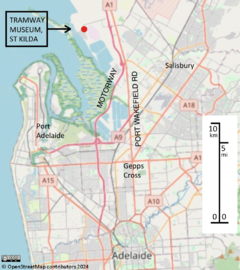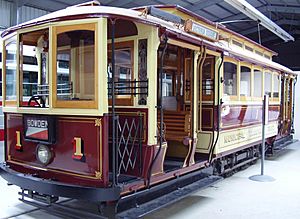Tramway Museum, St Kilda facts for kids
 |
|
 |
|
| Established | 1958 |
|---|---|
| Location | 300–360 St Kilda Road, St Kilda, South Australia |
| Type | Tramway museum |
| Collections | Trams and trolleybuses made or used in South Australia |
| Collection size | As of 2024[update]: 24 trams, 1 tram-hauled horsebox, 5 trolleybuses, 2 horse trams, 1 diesel bus |
| Visitors | Open noon–5 pm on Sundays and most public holidays. |
| Owner | Australian Electric Transport Museum (SA) Inc. |
| Public transit access | No public transport |
| Nearest car park | Ample on site; free |
The Tramway Museum, St Kilda is a special place in Adelaide, South Australia. It's Australia's main museum for trams from the 1800s and 1900s. You can find it in St Kilda, about 24 kilometres (15 miles) north of Adelaide's city centre.
The museum is run by a group of volunteers called the Australian Electric Transport Museum (SA) Inc. They work hard to study, protect, and fix up old trams that were used or built in Adelaide. They also have a small collection of buses and trolleybuses. When you visit, you pay an entrance fee, and then you can enjoy unlimited free rides on the trams! The trams travel along a 1.6-kilometre (1 mile) track between the museum and a fun adventure playground.
Contents
What You Can See at the Museum
This museum is very unique! It's one of the few transport museums in the world that has at least one example of almost every main type of tram that ran on city streets.
The museum started on an empty piece of land in 1958. Now, in As of 2024[update], it has 24 electric trams, 2 horse trams, and even a horsebox that a tram used to pull. There are also 5 trolleybuses and a diesel bus. This bus is like the ones that ran when the street tram system closed in 1958.
Inside the museum, you'll find an entrance area, a bookshop, and displays that explain the history of trams. There's also a special archive with old documents. To keep the trams in great shape, the museum has two workshops and other storage buildings. They even have a "travelling workshop," which is an old Melbourne tram!
The museum is run by volunteers and mostly uses money from visitor tickets to keep going. Bigger projects get help from museum members and sometimes from the South Australian Government or the Salisbury Council. The Salisbury Council helped a lot in 1972 by getting money to build the tramway track and put up the wires for the trams. Tram trials started in 1973, and the museum officially opened in 1974. Over the years, more workshops and depots were built to hold the growing collection of trams.
Meet the Tram Fleet

The museum has trams from different time periods.
Horse Trams: The Early Days
Before electric trams, there were horse trams! From 1878 to 1917, over 150 horse trams ran on about 120 kilometres (75 miles) of track. The museum has horse tram no. 18, which is fully restored. You can also see tram no. 15, which is displayed in its "before restoration" condition. This shows how much work goes into fixing up these old vehicles.
Electric Trams: A New Era
Electric trams started running in 1909. The MTT (Municipal Tramways Trust) managed them until 1958. At its busiest, the MTT had over 300 trams and a network of about 100 kilometres (62 miles). After 1958, only the line from Glenelg remained.
The museum has at least one tram of each main type from the MTT era. It also has two trams from Melbourne. One of them, W-class Melbourne tram no. 294, was actually built in Adelaide! The other Melbourne tram (W7 class 1013) has been changed to make it easy for wheelchairs to get on. The museum also has a Sydney R1 Class tram on loan from the Sydney Tramway Museum.
Trolleybuses and Motor Buses
The museum also preserves several trolleybuses. These are like buses but get their power from overhead electric wires. They have a 1925 Garford, a 1937 AEC 661T, and a 1942 double-deck Leyland. There's also a 1945 single-deck Leyland and a 1952 Sunbeam MF2B. A 1954 AEC Regal IV motor bus is also part of the collection.
| Adelaide Trams at the Museum (As of 2023[update]) | ||
|---|---|---|
| Type | Number | Notes |
| Horse | 15, 18 | Car 18 is fully restored. Car 15 shows how trams look before restoration. |
| A | 1
14, 15 (coupled) |
Tram 1 is operational for special events. Trams 14 and 15 are a restored pair, called "Bib and Bub." |
| B | 42 | Operational. |
| C | 186 | Operational. |
| D | 192 | This tram used to run in Melbourne. Operational. |
| E | 118 | Converted back from a Type E1. Operational. |
| E1 | 111 | Operational. |
| F, F1 | 244, 264, 282 | Types F1 numbers 264 and 282 are operational. |
| G | 303 | Operational. |
| H | 351, 352, 360, 362, 364, 365, 378 | As of 2024[update], 351 is on display, waiting to be changed to an older power system. 352 is operational. 360 and 365 are usually operational. 362, 364, and 378 (an old restaurant tram) are operational but usually on display inside. |
| H1 | 381 | Operational. |
| Trams from Other States at the Museum (As of 2023[update]) | |||
|---|---|---|---|
| Ran in city of | Class | Number | Notes |
| Ballarat | – | 21 | On display. This tram was Adelaide's Type A car number 10 before it went to Ballarat. |
| Melbourne | W2 | 294 | Operational. This tram was built in Adelaide for Melbourne. |
| Melbourne | W2 | 354 | Used for maintaining the tracks and overhead wires. |
| Melbourne | W7 | 1013 | Operational. |
| Sydney | R1 | 1971 | Operational. This tram is on loan from the Sydney Tramway Museum. |
How the Museum Operates
The museum follows strict safety rules, just like all other railways in Australia. During the COVID-19 pandemic in 2019 and 2020, the museum stopped running trams. This gave them time to update their safety plans to meet new requirements. During this time, the Salisbury Council also made some big improvements to the tram line. They fixed curves, re-laid tracks at crossings, and replaced some overhead poles and wires. The public tram service started again in May 2021.
Visiting the Museum
The museum is open on Sunday afternoons. During school holidays and public holidays, it's also open on Wednesday afternoons. If you want to get there by public transport, the Salisbury Council has a community bus. It runs three times on Sundays from the Parabanks Shopping Centre, which is near the Salisbury railway station and bus interchange.
Gallery
See also
- St Kilda adventure playground
- Tram museum website



















